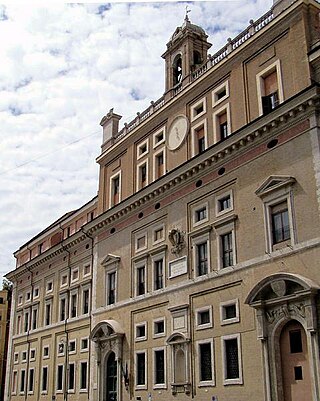
The Ministry of Culture is the ministry of the Government of Italy in charge of national museums and the monuments historiques. MiC's headquarters are located in the historic Collegio Romano Palace and the current Minister of Culture is Gennaro Sangiuliano.

The Biblioteca Comunale degli Intronati is the public library located at Via della Sapienza #3 of the comune of Siena, in Tuscany, Italy.
AthenaPlus is a CIP best practice network started in March 2013 which aims to facilitate access to networks of cultural heritage, enrich metadata, as well as improve search, retrieval and re-use of Europeana's content by enhancing multilingual terminology management and the export/publication tool. By the end of the project, AthenaPlus will contribute more than 3.6 millions of metadata records to Europeana, from both public and private sectors, focusing mainly on museums content. In addition to enabling access to cultural heritage, AthenaPlus is also focused on creative use of content, and adapting data to users with different needs by means of tools that support the development of virtual exhibitions, tourist and didactic applications.
Vittorio Emanuele Vincenzo Giuseppe Calestani was an Italian botanist at the University of Modena, whose work included a classification system for angiosperms.
The following is a timeline of the history of the city of Bergamo in the Lombardy region of Italy.
The following is a timeline of the history of the city of Syracuse, Sicily, Italy. Syracuse was the main city of Sicily from 5th century BCE to 878 CE.
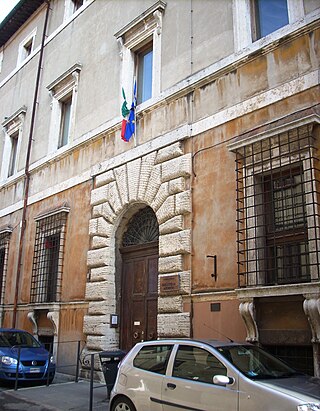
The Biblioteca Augusta is a public library in Perugia, Italy, founded by Prospero Podiani. It opened in 1623, housed in the former Palazzo Meniconi on the Piazza Piccola. It currently operates from the Palazzo Conestabile della Staffa in the Porta Sole area of the city.

The Biblioteca Civica of Bergamo, Italy, is a public library founded by Giuseppe Alessandro Furietti. Its headquarters occupy the Palazzo Nuovo di Bergamo on the Piazza Vecchia.

The Biblioteca Classense is the public library of Ravenna, Italy.
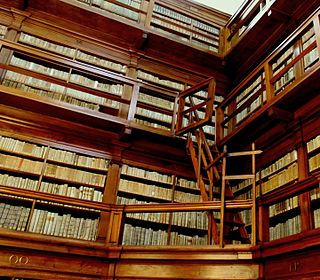
The Biblioteca Teresiana of Mantua, Italy, is a public library founded by sovereign Maria Theresa.
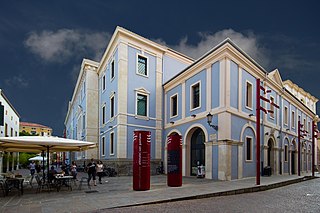
The Biblioteca Civica of Padua, Italy, is a public library founded in 1839 by Gerolamo Polcastro. Since 2009 it operates from headquarters in the Centro culturale Altinate/San Gaetano. Its collections include manuscripts produced by Alberto Fortis.
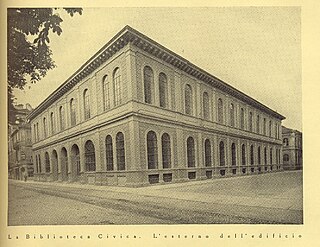
The Biblioteca Civica Centrale of Turin, Italy, is a public library established in 1869. It belongs to the Biblioteche Civiche Torinesi library system. Among its collections are manuscripts produced by Vincenzo Gioberti.

The Biblioteca Civica Berio of Genoa, Italy, is a public library founded by Carlo Giuseppe Vespasiano Berio. Around 1998 it moved into the former Seminario arcivescovile di Genova in the Carignano quartiere. Among its collections is the library of Demetrio Canevari.
The following is a timeline of the history of the city of Parma in the Emilia-Romagna region of Italy.

The Biblioteca Forteguerriana is a public library in Pistoia, Italy, founded in 1473 by Niccolò Fortiguerra. In 1967 it became the Biblioteca comunale Forteguerriana. It currently occupies the Palazzo della Sapienza.
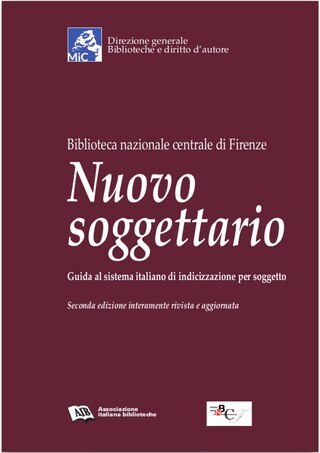
The Nuovo soggettario is a subject indexing system managed and implemented by the National Central Library of Florence, that in Italy has the institutional task to curate and develop the subject indexing tools, as national book archive and as bibliographic production agency of the Italian National Bibliography. It can be used in libraries, archives, media libraries, documentation centers and other institutes of the cultural heritage to index resources of various nature on various supports
The National Library Service of Italy is a Ministry of Cultural Heritage and Activities promoted network of Italian libraries, in collaboration with Regions and Universities, and coordinated by the Central Institute for the Union Catalogue of Italian Libraries and Bibliographic Information.
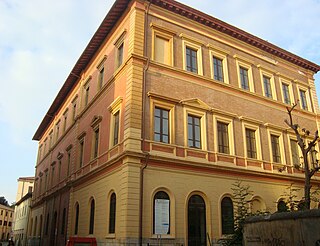
The Biblioteca Chelliana is a public library in Grosseto, Italy, founded in 1860 by Giovanni Chelli. In 1865 it became a public library as Biblioteca comunale Chelliana. It currently occupies the Palazzo Mensini built in 1898.

Enrico Narducci was an Italian librarian, bibliographer and paleographer.
Aldo Ferrabino was an Italian historian, philosopher, librarian, writer, and poet. A graduate of the University of Turin, he taught ancient history at the University of Padua and the Sapienza University of Rome, later becoming rector at the University of Padua in 1947. From 1948 to 1954, he served in the Italian Senate for the Christian Democracy party. In 1950, he become a correspondent for the Accademia dei Lincei, and the president of the Istituto Centrale per il Catalogo Unico. From 1954 to 1972, he was president of the Treccani encyclopaedia. In 1956, he was elected the president of the Dante Alighieri Society. In 1957, he co-founded the magazine Il Veltro with Vincenzo Cappelletti. Considered an expert on Christology and the philosophy of history, he was made a Knight of the Civil Order of Savoy in 1970.












